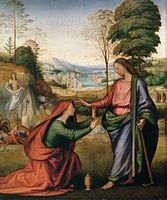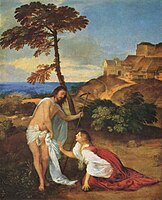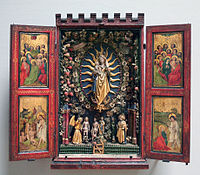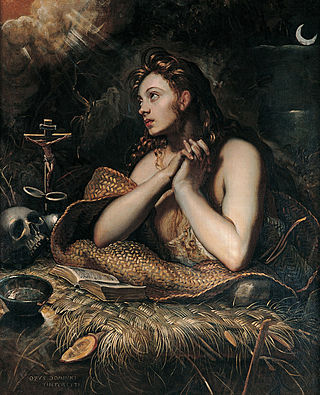
Mary Magdalene was a woman who, according to the four canonical gospels, traveled with Jesus as one of his followers and was a witness to his crucifixion and resurrection. She is mentioned by name twelve times in the canonical gospels, more than most of the apostles and more than any other woman in the gospels, other than Jesus's family. Mary's epithet Magdalene may be a toponymic surname, meaning that she came from the town of Magdala, a fishing town on the western shore of the Sea of Galilee in Roman Judea.
The imperative mood is a grammatical mood that forms a command or request.
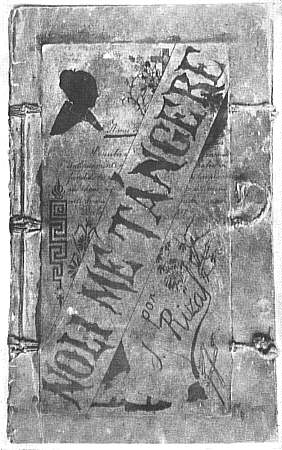
Noli Me Tángere is a novel by Filipino writer and activist José Rizal and was published during the Spanish colonial period of the Philippines. It explores perceived inequities in law and practice in terms of the treatment by the ruling government and the Spanish Catholic friars of the resident peoples in the late-19th century.

Nemo me impune lacessit is the national motto of Scotland. It also served as the national motto of the historic Kingdom of Scotland prior to the Treaty of Union 1707.

John 20:17 is the 17th verse of the twentieth chapter of the Gospel of John in the New Testament. It contains Jesus' response to Mary Magdalene right after he confronts her just outside his tomb after his resurrection. According to the longer ending of Mark's Gospel Mary Magdalene is the first person to whom Jesus shows himself alive after his resurrection.

John 20:13 is the thirteenth verse of the twentieth chapter of the Gospel of John in the New Testament of the Christian Bible. This verse occurs after Mary Magdalene has found Jesus' tomb empty, except for two angels.

Don't Tread on Me, usually stylized in all caps without an apostrophe, is a political slogan dating to the American Revolution.
Hibiscus noli-tangere is a species of flowering plant in the family Malvaceae. It is found only in Yemen. Its natural habitat is subtropical or tropical dry forests. It is threatened by habitat loss.
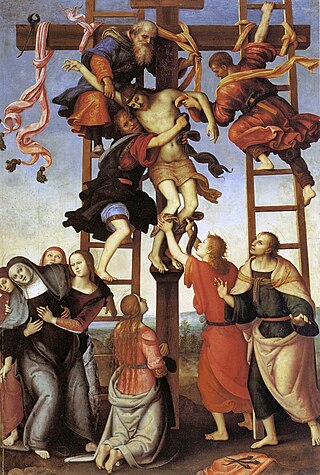
The Annunziata Polyptych is a painting cycle started by Filippino Lippi and finished by Pietro Perugino, whose central panel is now divided between the Galleria dell'Accademia and the Basilica dell'Annunziata, both in Florence, Italy. The polyptych had other six panels, which are housed in the Lindenau-Museum of Altenburg, the Metropolitan Museum of New York City, the Galleria Nazionale d'Arte Antica in Rome and in a private collection in South Africa.

Noli me tangere is a c. 1514 painting by Titian of the Noli me tangere episode in St John's Gospel. The painting, depicting Jesus and Mary Magdalene soon after the resurrection, is in oil on canvas and since the nineteenth century has been in the collection of the National Gallery in London.
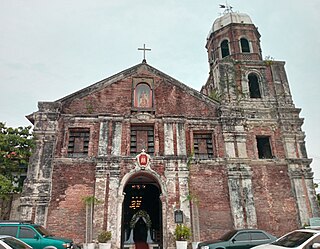
The Diocesan Shrine and Parish of Saint Mary Magdalene, also known as Kawit Church is the parish church of the municipality of Kawit, Cavite in the Philippines. The Roman Catholic church is one of the oldest churches in the Philippines, construction of the present church was started in 1737. The church, named after Jesus' disciple Mary Magdalene, was last restored in 1990 by the citizens of Kawit.

La Vie is a 1903 oil painting by Pablo Picasso. It is widely regarded as the pinnacle of Picasso's Blue Period.
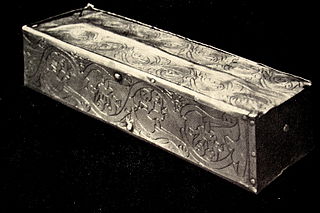
The Noli me tangere casket was a small silver-gilt casket made in 1356 for the Aachen Cathedral Treasury. It measured 15.2 cm in length, 3.7 cm in height and 4.8 cm in width. The casket was kept in the Marienschrein together with the key relics of the cathedral until the nineteenth century and the casket remained in the possession of the cathedral treasury until its destruction during the Second World War.

Noli Me Tangere is a large sculptural arrangement that forms part of the Alaleona Chapel in the church of Santi Domenico e Sisto, in Rome.
Noli me tangere is the Latin version of words spoken by Jesus to Mary Magdalene.

Noli me tangere, also known as Christ Appearing to Mary Magdalene in the Garden, is a c. 1525 painting by Correggio which depicts the noli me tangere interaction between Jesus and Mary Magdalene shortly after the Resurrection. It is currently in the collection of the Museo del Prado in Madrid.
Reimund Bieringer is a German theologian, biblical scholar, Professor Emeritus of New Testament Exegesis at the Faculty of Theology and Religious Studies, KU Leuven, Belgium, and a Roman Catholic priest of the Diocese of Speyer in Germany. The main areas of his research include the Second Letter to the Corinthians, the Gospel of John, and biblical hermeneutics.

Mary Magdalene with Eight Scenes from her Life is a c.1280-1285 tempera and gold on panel painting by the Master of the Magdalen, now in the Galleria dell'Accademia in Florence.

Noli me tangere is a fragment of a fresco of c. 1498–1500 by Bramantino depicting Jesus and Mary Magdalene soon after the resurrection. It was originally in the church of Santa Maria del Giardino in Milan and since 1867 in the Pinacoteca del Castello Sforzesco in the same city, to which it was given by Prospero Moisè Loria.

Noli me tangere is an oil-on-canvas painting by Andrea del Sarto, executed c. 1510, depicting Jesus and Mary Magdalene soon after the resurrection. It was the first painting he produced for the Augustinian San Gallo church in Florence, as recorded by Anonimo Magliabechiano and in Vasari's Lives of the Artists, and he later produced the San Gallo Annunciation and The Disputation on the Trinity for the same church. It is now in the Uffizi.







